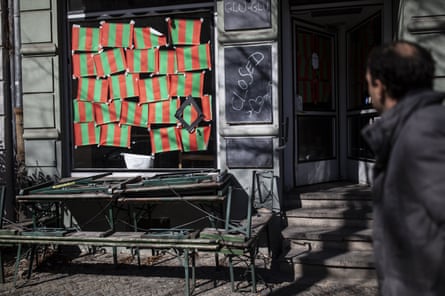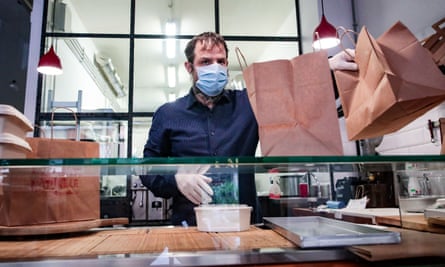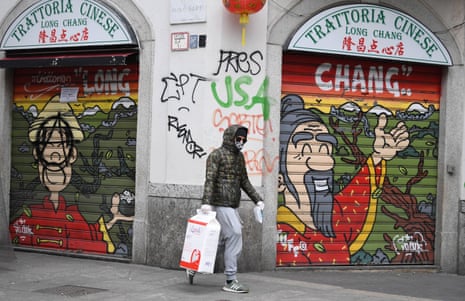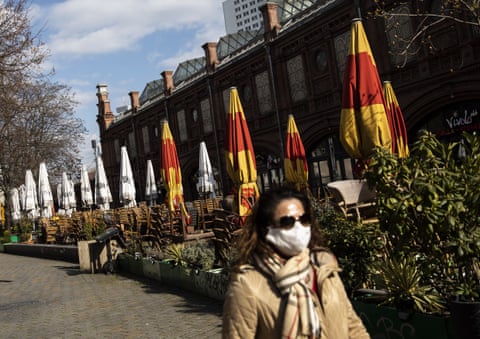If there is such a thing as a European way of life, restaurants like Föllerei in Berlin used to give a pretty good flavour of what it would taste like.
In a crammed 40 sq metre (430 sq ft) space tucked away in a side street of scruffy but fashionable Neukölln, the owner, Christiane Föll, has for the last 10 years served up sumptuous Franco-German cuisine, darting between 10 rickety wooden tables night after night to recommend the organic entrecôte, pour another glass of Spätburgunder or share the latest locally sourced gossip.
Since Berlin went into lockdown on 14 March, however, the front door at Föllerei (a play on the German word for gluttony) has remained shut – and it is unclear if it will ever open again.

As European countries nervously begin to extricate themselves from restrictions to curb the spread of Covid-19, shops are beckoning in customers, metro trains are returning to regular service, and even hairdressers are sharpening their scissors.
Only three countries – Austria, the Czech Republic and Italy – have put a tentative date on when restaurants can resume service. As such, almost an entire continent’s gastronomic culture remains in limbo.
“The future looks bleak,” said Föll, who has already had to lay off two of her four employees. If she were to remove one of the tables, the owner and maître d’ calculates, she could just about guarantee a safe distance between diners but would then struggle to cover her running costs.

“It just feels like personal bad luck,” said the 56-year-old, whose little restaurant managed to break even at the end of last year for the first time in a decade.
Last Wednesday, the German government announced it would help the food industry by cutting VAT from 19% to 7% from 1 July, though Berlin’s chamber of industry and trade fears many restaurants will already have been forced to go into administration by then.
“People don’t just fear for their livelihood – they are increasingly panicked,” said Thomas Lengfelder, the director of Berlin’s association for restaurants and hotels. “The corona restrictions will lead to a wave of bankruptcies like we have never seen before.”
On Tuesday, German economy minister Peter Altmaier conceded his government might be forced to set up a “rescue fund for gastronomy” unless full openings could happen soon.

In France, the cradle of modern European gastronomy, strict lockdown measures will end on 11 May but the government has yet to say when the country’s 240,000 restaurants and cafés can reopen. French media suggested last week that if the outbreak was under control at the end of the lockdown, they may be allowed to open in mid-June.
The government has promised to publish an “operational guide” outlining how restaurants and other outlets can maintain barrier and social distancing rules.
Roland Héguy, the president of the hotel industry union UMIH, said 2020 would be a “lost year” for members.
“It’s regrettable that we are the only sector that has no outlook for the future opening of our establishments, even when we are already working on practical guides on how to do our job while keeping our staff and customers safe,” Héguy said.
On 20 April, 18 of France’s most celebrated chefs published an open letter in Le Figaro warning that the country’s restaurants were “in danger of dying” and calling on the president, Emmanuel Macron, to allow them to open.

At the time of year when tables and chairs would normally be returning to pavements and terraces outside cafes and bars in Spain, the authorities are exploring how a phased return might work.
This month, the mayor of Madrid, José Luis Martínez-Almeida, said the city council was looking into reducing capacity in restaurants, enlarging outside seating areas and installing screens to separate diners.

“These measures are designed to allow businesses to reopen as soon as possible – while observing social distancing rules – so that they can make up their losses and the economy can be reactivated,” he told the Spanish TV programme Espejo Público.
In Austria, restaurants will be allowed to reopen from 15 May if they adhere to a set of rules, including a maximum number of four adults per table and a minimum 1m distance between groups. Waiters will be required to wear masks while taking orders and serving dishes.
Diners are advised to book tables in advance, to avoid queues and make it easier to trace possible infection chains further down the line.
Many restaurants across the continent are already improvising to adapt to the new reality. Towards the end of a normal April, the terrace at Capitano Del Popolo, a restaurant in the hilltop town of Orvieto, in Italy’s central Umbria region, would be buzzing with customers enjoying early spring.
Instead, chef Valentina Santanicchio is busy cooking made-to-order meals, packing them in boxes and delivering them to people’s homes on her bicycle.

“On the day we found out about the lockdown, I cried and panicked,” she said. “At that point, we understood that the situation was really serious but we also worried about the future. For the first week I was in shock as I tried to understand what it all meant. Then I tried to have a different outlook – do I close and abandon everything, or do I try to move forward in some way?”
Neighbourhood bars and restaurants are the lifeblood of many Italians towns, but their futures are in peril after more than seven weeks in lockdown.
Other restaurant owners in Orvieto, which is heavily dependent on tourism, have also adopted home delivery services, as much to keep themselves occupied as to mitigate the risk to business.
For Santanicchio, home delivery has been a novelty, albeit a successful one. Still, the bigger challenges for Italy’s catering businesses are yet to come. The country is in lockdown until 3 May, after which restrictions will gradually be eased, with bars and restaurants scheduled to open on 1 June. But FIPE, the Italian association for bars and restaurants, warned last week that as many as 50,000 across the country may be forced to close for good.

The businesses are entitled to claim €600 (£520) for each month closed and can apply for subsidised bank loans, repayable after two years. But payment of taxes owed during the lockdown has merely been postponed, and business owners still have to pay rent and bills. Staff have been furloughed but many are yet to receive their unemployment benefit.
“Even though I am lucky to have many customers who live locally, the only certainty I have right now is that I will lose 60% of customers overall,” Santanicchio said.
“People may be afraid to go to a restaurant or won’t have the money to spend. Coronavirus is very much the tip of the iceberg, because underneath there will be a frightening economic crisis.”
